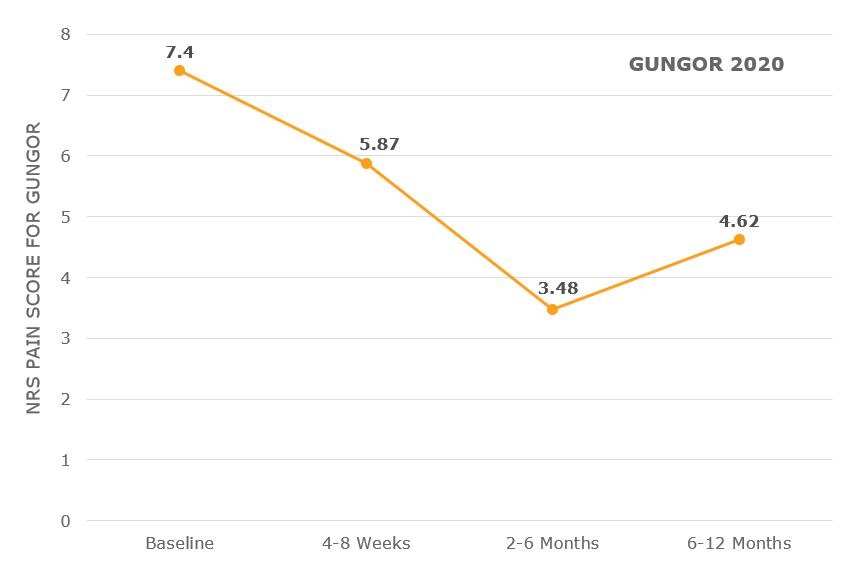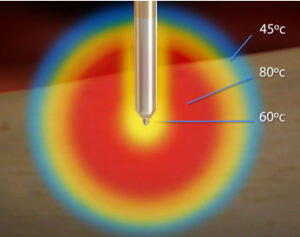The thoracic region, located in the middle and upper portions of the spine, allows the body to bend and twist. Pain in the thoracic region accounts for 48 percent of back pain cases.1 Back pain in this region is often caused by poor posture or muscle tension.
Limitations of Conventional Management Options
- Medial branch block (MBB) with local anesthetic with or without corticosteroids, together with intraarticular TFJ injection has been widely used to manage TFJ-origin pain; however many patient continue to complain of persistent pain.2
- Physical therapy and massage are unable to provide long-term analgesic benefit
 Advantages of Using COOLIEF* Cooled Radiofrequency
Advantages of Using COOLIEF* Cooled Radiofrequency
COOLIEF* Cooled RF is a minimally invasive procedure that ablates the nerves sending pain signals from the facet joint to the brain for up to 24 months.3 COOLIEF* Cooled RF is proven to be safe and effective for both patients seeking less-invasive pain relief intervention and those who are not appropriate candidates for surgery.
Specifically designed to treat complex anatomy of variable nerve courses, COOLIEF* Cooled RF uses water-cooled technology that enables more RF energy to safely deactivate pain-transmitting sensory nerves. This creates a larger, spherical lesion that distally projects 45% or greater beyond the probe’s tip.
- Demonstrates up to 24 months pain relief with improved physical function and a reduction in opioid medication usage.
- Delivers up to 3.7x more energy than standard RF
Evaluating CRFA in Treatment of Thoracic Pain4
A 2020 retrospective review published in Medicine evaluated the safety and efficacy of CRFA in treating thoracic pain. Researchers analyzed the outcomes of 40 subjects who received CRFA to manage chronic thoracic pain. Subjects were evaluated for pain and safety using the NRS at early (four to eight weeks), intermediate (two to six months) and long-term (six to 12 months) time intervals.
NRS Pain Scores for the 12-Month Time Point

At the early time point, subjects who received CRFA reported an average decrease of 1.53 points from baseline in the NRS.
At the intermediate time point, subjects who received CRFA reported an average decrease of 3.92 points from baseline in the NRS.
At the long-term time point, subjects who received CRFA reported an average decrease of 2.78 points from baseline in the NRS.
Key Takeaway: CRFA is an effective treatment for thoracic pain with minimal adverse effects. The majority of subjects did not require repeat treatment for more than 12 months.

Click here for Instructions for Use
References:
- Gungor S, Candan B. The efficacy and safety of cooledradiofrequency neurotomy in the treatment of chronic thoracic facet (zygapophyseal) joint pain: a retrospective study. Medicine (Baltimore). 2020;99(14):e19711.
- Chang MC. Effect of pulsed radiofrequency treatment on the thoracic media branch for managing chronic thoracic facet joint pain refractory to media branch block with local anesthetics. World neurosurgery. 2018;111:e644-8.
- Shih CL, Shen PC, Lu CC, et al. A comparison of efficacy among different radiofrequency ablation techniques for the treatment of lumbar facet joint and sacroiliac joint pain: a systematic review and meta-analysis. Clin Neurol Neurosurg. 2020;195:105854.
- Gungor S, Candan B. The efficacy and safety of cooledradiofrequency neurotomy in the treatment of chronic thoracic facet (zygapophyseal) joint pain: a retrospective study. Medicine (Baltimore). 2020;99(14):e19711.

 Advantages of Using COOLIEF* Cooled Radiofrequency
Advantages of Using COOLIEF* Cooled Radiofrequency